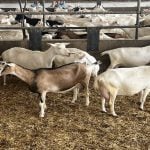Finally, says senior Agriculture Canada senior analyst David Culver,
the government is seeing concrete results from its 1995 decision to
abolish the historic prairie grain transportation subsidy.
They come in the first results of the 2001 census of agriculture
published May 15 that show prairie wheat acreage down and strong growth
in livestock numbers and acreage of alternative crops.
“I think we are starting to see some of the changes flowing from policy
changes,” Culver said May 16. “Pulse crops, hog farms, livestock. Some
Read Also

VIDEO: Agritechnica Day 4: Robots and more robots, Nexat loves Canada and the trouble with tariffs
Agritechnica Day 4: Robots and more robots, Nexat loves Canada and the trouble with tariffs.
of those changes are amazing. I think it is positive.”
On the Prairies, farmers and economists agree that the end of the Crow
Benefit rail transportation subsidy set in motion events and farmer
decisions that are reflected in changing farming patterns reported in
the census.
“It has made grain farming that much less profitable at a time when
prices are down and other countries are increasing subsidies rather
than cutting them,” Canadian Federation of Agriculture vice-president
and former Saskatchewan Wheat Pool vice-president Marvin Shauf said May
17. The industry, still one of the key prairie farm sectors, is weaker
for it.
“I think the loss of the Crow really was a pivotal point,” agreed
University of Saskatchewan agricultural economist Rose Olfert. “The
trends that we see now will continue to show up and perhaps accelerate.”
The trends were notable across the Prairies.
In Saskatchewan, although wheat remains the king crop in area planted,
wheat acres declined by more than 16 percent to 15.2 million acres.
Field pea and lentil acreage more than doubled in 2001 and more than
one million acres were planted to chickpeas.
Alberta, Canada’s largest agricultural province, increased its cattle
herd by 6.6 million head to give it 43 percent of the national herd and
saw potato acreage increase 85 percent.
In Manitoba, wheat remained the biggest single grain crop but more than
one-third of Manitoba farms are cattle operations.
“With the removal of the Western Grain Transportation Act in 1995,
transportation costs to grain producers increased,” said the Statistics
Canada census analysis. “This, along with decreasing grain prices and
increasing livestock prices, made the feeding of livestock a good
alternative to selling grain.”
Culver said this reaction was a few years late in coming.
When the WGTA was abolished and a $1.6 billion Crow buyout was offered
in 1996, the government expected grain farmers to quickly get the
message that exporting raw grain was not good business. Instead, little
changed at first because grain prices were high in the mid-1990s and
the full impact of higher transportation costs were masked.
In Foremost, Alta., Brenda Stryker said her farm and her neighbours
have reacted to prices and policy changes by trying to avoid crops that
do not return a profit or that must be marketed through the Canadian
Wheat Board.
Still, this year also illustrates that some existing policies still
influence farmer planting decisions.
On their 6,000 acre farm in southeastern Alberta, the Strykers are
seeding more than a normal acreage of wheat and durum this year – low
priced crops that are marketed through the CWB.
The reason is the weather. The area has been bone dry for several years
and even late spring snow has not been enough.
“We’re planting more than normal acres of wheat and durum because of
crop insurance,” she said May 17.
“We don’t normally plant for crop insurance but this year, we need to
be cautious. We can’t afford to not have revenue from those acres.”














